When I was teacher, I would often hear my students talk about their other instructors. It didn’t take long to discover who were the superstars.
They were the ones whose lessons were both rigorous and engaging–the ones who greeted students at the door, embedded class routines, differentiated learning, assessed meaningfully, and provided constant feedback.
These educators weren’t perfect, but they were engaged.
Lessons From Industry Research
I was taking a look at Gallop Poll’s 2013 State of the American Workplace.
In it Gallop’s researchers reviewed over 25 million responses in their analysis of 100 million American workers.
And guess what? Their research shows how these same “engagement” practices work in business.
Here are five points I pulled that can also apply to school communities:
1. “To win customers — and a bigger share of the marketplace — companies must first win the hearts and minds of their employees.”
So how do we win hearts and minds of our students and teachers?
First, this happens through relationships where we treat others as people, not as products. Second, it happens through providing meaningful, substantive instruction and feedback.
2. “…the top 25% of teams — the best managed — versus the bottom 25% in any workplace — the worst managed — have nearly 50% fewer accidents and have 41% fewer quality defects.”
Leadership requires good management. And when leaders have lost the trust of those whom they lead, they will not see improvement. Defects (not creativity or productivity) are the result of when we fail to effectively communicate, efficiently organize, or consistently reinforce expectations.
Master teachers know this truth well.
One of my first school leaders told me once, “Leading a school or a district is like managing a classroom. When you approach it with the same preparation, planning, monitoring, and attention that a strong teacher shows, you will see good results.”
That common sense advice goes along way in any setting
3. Gallop identifies “Three Ways to Accelerate Employee Engagement”.
The study found that organizations have improved results when they do the following:
- Select the Right People
- Develop Employees’ Strengths
- Enhance Employees’ Wellbeing
Nowhere in the study do Gallop researchers find a positive correlation between focusing on weaknesses and increased productivity.
The opposite is true: when you focus on the strengths, not the weaknesses, of your team, it inspires others to improve.
When you spend time focusing on the weaknesses of your team, it drags everyone down as well.
My former principal cautioned me that leaders should avoid a “shot gun approach” to correcting problems. In other words, if you have one person on your team who needs correction, do it one-on-one.
Shooting out an email warning everyone or lecturing your entire staff in a meeting is not productive and can actually damage, not improve morale and productivity.
Focusing on weaknesses doesn’t work in business, classrooms, schools or relationships.
4. “Satisfied or happy employees are not necessarily engaged employees.”
This is important to note. Happy and engaged are different.
Gallop found that engaged employees are more motivated than ones simply induced through perks or monetary incentives.
The research asserts that “engagement” means giving people well-defined roles, helping them “make strong contributions”, staying “connected to their larger team and organization,” and “continuously progressing.”
In other words, people are motivated when they understand the purpose of their work and find significant meaning in it, not just by “feel good” incentives.
5. 240%
The Gallop poll ends with an amazing statistic:
“When organizations successfully engage their customers and their employees, they experience a 240% boost in performance-related business outcomes compared with an organization with neither engaged employees nor engaged customers.”
That’s right, 240%!
Can you imagine what kind of experience you could have if students, teachers, parents, and staff were fully engaged together in the business of learning?
Conclusion
Your school may not be a for-profit industry where the bottom line is how much money the company makes. But we do have a product: students and a school community who are engaged, learning, growing, and achieving success.
Success in school doesn’t happen by just focusing on test scores, evaluations, or wins/losses. Data is important, but it must be used to a higher end.
If the research is correct, success begins when we first create an environment where people know why they come to work, how their roles are defined, and what they can do to develop their strengths. Once they are engaged, watch out for incredible growth potential.
Now It’s Your Turn
What are examples you have seen when others are fully engaged in their work? What are some steps you can take to increase your own engagement and that of your team?
Sign-Up For Free Updates
When you enter your email address here, you will automatically receive my newest posts. Let’s keep learning together!




